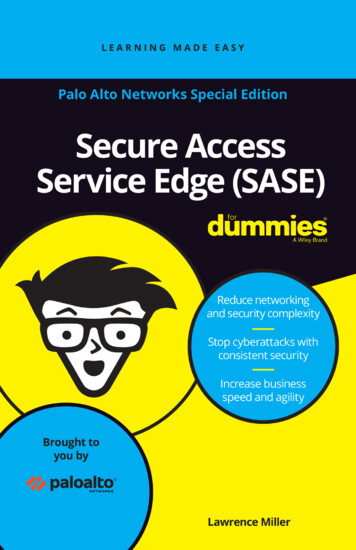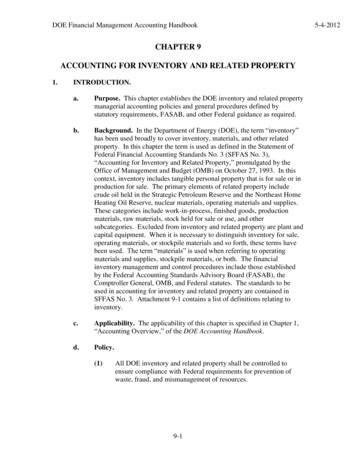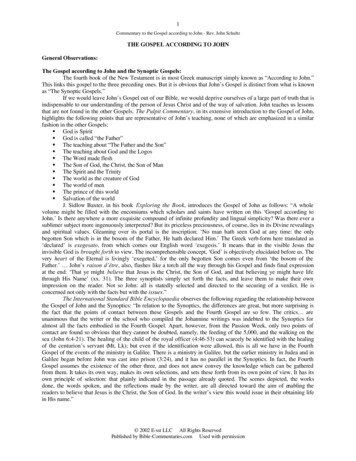
Transcription
These materials are 2020 John Wiley & Sons, Inc. Any dissemination, distribution, or unauthorized use is strictly prohibited.
Secure AccessService Edge(SASE)Palo Alto Networks Special Editionby Lawrence MillerThese materials are 2020 John Wiley & Sons, Inc. Any dissemination, distribution, or unauthorized use is strictly prohibited.
Secure Access Service Edge (SASE) For Dummies , Palo AltoNetworks Special EditionPublished byJohn Wiley & Sons, Inc.111 River St.Hoboken, NJ 07030-5774www.wiley.comCopyright 2020 by John Wiley & Sons, Inc., Hoboken, New JerseyNo part of this publication may be reproduced, stored in a retrieval system or transmitted in anyform or by any means, electronic, mechanical, photocopying, recording, scanning or otherwise,except as permitted under Sections 107 or 108 of the 1976 United States Copyright Act, withoutthe prior written permission of the Publisher. Requests to the Publisher for permission should beaddressed to the Permissions Department, John Wiley & Sons, Inc., 111 River Street, Hoboken, NJ07030, (201) 748-6011, fax (201) 748-6008, or online at http://www.wiley.com/go/permissions.Trademarks: Wiley, For Dummies, the Dummies Man logo, The Dummies Way, Dummies.com,Making Everything Easier, and related trade dress are trademarks or registered trademarks of JohnWiley & Sons, Inc. and/or its affiliates in the United States and other countries, and may not beused without written permission. All other trademarks are the property of their respective owners.John Wiley & Sons, Inc., is not associated with any product or vendor mentioned in this book.LIMIT OF LIABILITY/DISCLAIMER OF WARRANTY: THE PUBLISHER AND THE AUTHOR MAKE NOREPRESENTATIONS OR WARRANTIES WITH RESPECT TO THE ACCURACY OR COMPLETENESS OFTHE CONTENTS OF THIS WORK AND SPECIFICALLY DISCLAIM ALL WARRANTIES, INCLUDINGWITHOUT LIMITATION WARRANTIES OF FITNESS FOR A PARTICULAR PURPOSE. NO WARRANTYMAY BE CREATED OR EXTENDED BY SALES OR PROMOTIONAL MATERIALS. THE ADVICEAND STRATEGIES CONTAINED HEREIN MAY NOT BE SUITABLE FOR EVERY SITUATION. THISWORK IS SOLD WITH THE UNDERSTANDING THAT THE PUBLISHER IS NOT ENGAGED INRENDERING LEGAL, ACCOUNTING, OR OTHER PROFESSIONAL SERVICES. IF PROFESSIONALASSISTANCE IS REQUIRED, THE SERVICES OF A COMPETENT PROFESSIONAL PERSON SHOULD BESOUGHT. NEITHER THE PUBLISHER NOR THE AUTHOR SHALL BE LIABLE FOR DAMAGES ARISINGHEREFROM. THE FACT THAT AN ORGANIZATION OR WEBSITE IS REFERRED TO IN THIS WORKAS A CITATION AND/OR A POTENTIAL SOURCE OF FURTHER INFORMATION DOES NOT MEANTHAT THE AUTHOR OR THE PUBLISHER ENDORSES THE INFORMATION THE ORGANIZATIONOR WEBSITE MAY PROVIDE OR RECOMMENDATIONS IT MAY MAKE. FURTHER, READERSSHOULD BE AWARE THAT INTERNET WEBSITES LISTED IN THIS WORK MAY HAVE CHANGED ORDISAPPEARED BETWEEN WHEN THIS WORK WAS WRITTEN AND WHEN IT IS READ.For general information on our other products and services, or how to create a custom ForDummies book for your business or organization, please contact our Business DevelopmentDepartment in the U.S. at 877-409-4177, contact info@dummies.biz, or visit www.wiley.com/go/custompub. For information about licensing the For Dummies brand for products or services,contact BrandedRights&Licenses@Wiley.com.ISBN 978-1-119-69602-5 (pbk); ISBN 978-1-119-69608-7 (ebk)Manufactured in the United States of America10 9 8 7 6 5 4 3 2 1Publisher’s AcknowledgmentsSome of the people who helped bring this book to market include thefollowing:Project Editor: Elizabeth KuballAssociate Publisher: Katie MohrEditorial Manager: Rev MengleBusiness DevelopmentRepresentative: Karen HattanProduction Editor:Tamilmani VaradharajSpecial Help: Shannon Bonfiglio,Carmine Clementelli,Matt De Vincentis,Rachna SrivastavaThese materials are 2020 John Wiley & Sons, Inc. Any dissemination, distribution, or unauthorized use is strictly prohibited.
Table of ContentsINTRODUCTION. 1About This Book. 2Foolish Assumptions. 2Icons Used in This Book. 3Beyond the Book. 3CHAPTER 1:The Evolution of Networking. 5The Journey to the Cloud — And Beyond. 5The Rise of Mobile Computing. 6The Impact on Branch Networking and WAN Architectures. 8The SASE Vision. 10Modern Networking and Security ChallengesRevisited with SASE. 11CHAPTER 2:SASE Use Cases. 13Mobile and Remote Users. 13The limitations of traditional remote access VPNs. 14Unsatisfactory compromises. 15A modern architecture for the mobile workforce. 16Branch and Retail. 17The challenges of traditional branch/retail networking. 18Augmenting MPLS with direct Internet access. 19A modern architecture for branch transformation. 20CHAPTER 3:SASE Networking Capabilities. 21Software-Defined Wide-Area Network. 21Virtual Private Network. 25Zero Trust Network Access. 27Quality of Service. 29CHAPTER 4:SASE Security Capabilities. 31Firewall as a Service. 31Domain Name System Security. 33Threat Prevention. 36Secure Web Gateway. 37Data Loss Prevention. 40Cloud Access Security Broker. 42Table of ContentsiiiThese materials are 2020 John Wiley & Sons, Inc. Any dissemination, distribution, or unauthorized use is strictly prohibited.
CHAPTER 5:Ten Benefits of SASE. 47Complete Visibility across Hybrid Environments. 47Control of Users, Data, and Apps. 48Monitoring and Reporting. 48Less Complexity. 49Consistent Data Protection Everywhere. 49Reducing Costs. 50Lower Administrative Time and Effort. 50Reducing Need for Integration. 50Better Network Performance and Reliability. 51Greater Agility. 51GLOSSARY. 53ivSecure Access Service Edge (SASE) For Dummies, Palo Alto Networks Special EditionThese materials are 2020 John Wiley & Sons, Inc. Any dissemination, distribution, or unauthorized use is strictly prohibited.
IntroductionWith increasing numbers of mobile users, branch offices,data, and services located outside the protections oftraditional network security appliances, organizationsare struggling to keep pace and ensure the security, privacy,and integrity of their networks and, more important, theircustomers.Today, many of the current network security technologieson the market were not designed to handle all of the types oftraffic and security threats that a modern organization has to dealwith. This forces organizations to adopt multiple point productsto handle different requirements, such as secure web gateways,firewalls, secure virtual private network (VPN) remote access,and software-defined wide area networks (SD-WANs). For everyproduct, there is an architecture to deploy, a set of policies toconfigure, an interface to manage, as well as its own set of logs.This creates an administrative burden that introduces cost, complexity, and gaps in security posture.To address these challenges, secure access service edge (SASE)has emerged. Originally defined by Gartner, a SASE (pronounced“sassy”) solution is designed to help organizations embrace cloudand mobility by providing network and network security servicesfrom a common cloud-delivered architecture. A SASE solutionmust provide consistent security services and access to all typesof cloud applications — for example, public cloud, private cloud,and software as a service (SaaS), platform as a service (PaaS), andinfrastructure as a service (IaaS) — delivered through a commonframework. By removing multiple point products and adoptinga single cloud-delivered SASE solution, organizations can reducecomplexity while saving significant technical, human, and financial resources.In SASE For Dummies, you’ll learn about this new approach to networking and security, including its core capabilities and keybenefits for organizations in the modern digital workplace.Introduction1These materials are 2020 John Wiley & Sons, Inc. Any dissemination, distribution, or unauthorized use is strictly prohibited.
About This BookSecure Access Service Edge (SASE) For Dummies consists of five chapters that explore the following:»» Modern trends and their impact on the evolution of networkingarchitectures (Chapter 1)»» SASE use cases (Chapter 2)»» Networking capabilities in SASE (Chapter 3)»» Security capabilities in SASE (Chapter 4)»» Key SASE benefits (Chapter 5)Each chapter is written to stand on its own, so if you see a topicthat piques your interest feel free to jump ahead to that chapter.You can read this book in any order that suits you (though I don’trecommend upside down or backward).There’s also a glossary in case you get stumped on any acronymsor terms.Foolish AssumptionsIt’s been said that most assumptions have outlived their uselessness, but I assume a few things nonetheless!Mainly, I assume that you work in an organization that is looking for a better way to simplify your approach to networking andsecurity services. Perhaps you’re an IT executive or managersuch as a chief information officer (CIO), chief technology officer (CTO), or chief information security officer (CISO). Or perhapsyou’re a network or security architect or engineer.As such, this book is written for technical readers with a generalunderstanding of cloud, networking, and security concepts andtechnologies.If any of these assumptions describes you, then this is the bookfor you. If none of these assumptions describes you, keep readinganyway — it’s a great book and you’ll learn quite a bit about SASE.2Secure Access Service Edge (SASE) For Dummies, Palo Alto Networks Special EditionThese materials are 2020 John Wiley & Sons, Inc. Any dissemination, distribution, or unauthorized use is strictly prohibited.
Icons Used in This BookThroughout this book, I occasionally use special icons to callattention to important information. Here’s what to expect:This icon points out important information you should committo your nonvolatile memory, your gray matter, or your noggin —along with anniversaries and birthdays!Tips are appreciated, never expected — and I sure hope you’llappreciate these useful nuggets of information.These alerts point out the stuff your mother warned you about(well, probably not), but they do offer practical advice to help youavoid potentially costly or frustrating mistakes.Beyond the BookThere’s only so much I can cover in 64 short pages, so if youfind yourself at the end of this book, thinking, “Gosh, this wasan amazing book! Where can I learn more?,” check out n3These materials are 2020 John Wiley & Sons, Inc. Any dissemination, distribution, or unauthorized use is strictly prohibited.
IN THIS CHAPTER»» Understanding the role of the cloud indigital transformation strategies»» Untethering users with mobilecomputing»» Evolving the network architecture»» Discovering a new approach toenterprise networking and security»» Addressing networking and securitychallenges with SASEChapter1The Evolution ofNetworkingIn this chapter, you learn how cloud and mobile computingtrends have changed enterprise networking and how a secureaccess service edge (SASE, pronounced “sassy”) can helpyour organization address its modern networking and securityrequirements.The Journey to the Cloud — And BeyondWe live in an age of cloud and digital transformation. Usersand applications are moving outside the traditional networkperimeter, accessing an ever-increasing number of applications —including software as a service (SaaS), platform as a service (PaaS),and infrastructure as a service (IaaS) application workloads in thepublic cloud. Organizations face the challenge of proactively protecting their users, applications, and data from security threats,without compromising user experience.CHAPTER 1 The Evolution of Networking5These materials are 2020 John Wiley & Sons, Inc. Any dissemination, distribution, or unauthorized use is strictly prohibited.
The 2019 RightScale State of the Cloud Report from Flexera foundthat public cloud adoption among organizations has grown to91 percent and companies now run a majority of their workloadsin the cloud (38 percent of their workloads run in public cloud and41 percent run in private cloud). Companies are also using SaaS,PaaS, and IaaS offerings from multiple cloud providers — nearlyfive clouds on average.As cloud computing continues to play an integral role in digitaltransformation, the enterprise network must evolve to supportnew technologies and business initiatives.The Rise of Mobile ComputingThe proliferation of mobile devices in our everyday lives is indisputable. According to the June 2019 Ericsson Mobility Report, thereare now nearly 8 billion mobile subscriptions worldwide. By theend of 2024, Ericsson predicts that 95 percent of all subscriptionswill be mobile broadband. Many smartphones now contain morecomputing power than the average desktop computer. People areincreasingly using smartphones to access the Internet and SaaSapps, not only for personal computing needs, but also for workpurposes.At the same time, public Wi-Fi hotspots are now available practically everywhere. This ubiquitous connectivity enables users towork on their laptops, tablets, and smartphones from practicallyanywhere.Organizations are increasingly taking advantage of these trendsby implementing bring your own device (BYOD) policies andembracing remote working as a new norm in the modern digitalworkplace. Remote working increases productivity and, ironically,promotes a work-life balance that many employees prefer insteadof commuting to an office and “clocking in and out” every day.Mobile and remote computing introduce new networking andsecurity challenges that traditional remote access connectivity isnot designed to address.6Secure Access Service Edge (SASE) For Dummies, Palo Alto Networks Special EditionThese materials are 2020 John Wiley & Sons, Inc. Any dissemination, distribution, or unauthorized use is strictly prohibited.
THE TOP FIVE MOBILESECURITY THREATSMobile devices have emerged in recent years as the leading platformfor cybercrime and cybersecurity threats against organizations.However, organizations are still working on ways to protect thesemobile devices, especially because they often contain a mixture ofbusiness and personal data and operate both on and off the enterprise network.Here are some of the top mobile security threats today: Phishing: In the past, phishing attacks largely took place by email.Today, they’re primarily happening through mobile channels, suchas text messaging, Facebook Messenger, WhatsApp, and phonywebsites that look legitimate. Mobile malware: Every website visited or link clicked has thepotential to infect mobile devices with malware, such as spyware,ransomware, Trojan viruses, adware, and others. This risk of infection by malware on mobile devices is often higher than on desktopor laptop computers because most mobile users don’t install antimalware software on their smartphones and tablets and don’trecognize the threat. Fake public Wi-Fi networks: Many mobile workers today usepublic Wi-Fi networks at coffee shops, airports, restaurants, andother locations whenever they’re working outside the office.Cybercriminals are aware of this trend and often leverage thesenetworks to trick mobile users into connecting to fake Wi-Finetworks, thereby potentially compromising sensitive data. Malicious apps: The world is full of software applications that canbe used over the Internet or downloaded from websites (includingthe Apple App Store and Google Play Store). Many of these applications are legitimate and safe to use, but there are also thousands that aren’t. Thus, downloading an app or granting an apppermission to access functions on a mobile device may expose theuser’s company to a host of security and privacy risks. Some appseven collect data without asking the user for permission.(continued)CHAPTER 1 The Evolution of Networking7These materials are 2020 John Wiley & Sons, Inc. Any dissemination, distribution, or unauthorized use is strictly prohibited.
(continued) Data leaks: Data leaks occur with any unauthorized or unintentional transfer of data from inside an organization to an externalparty or destination. These leaks can range from someone inside acompany accidentally transferring confidential or sensitive data toan unsanctioned/unapproved cloud application or oversharingconfidential or sensitive data on cloud sharing apps or publiccloud storage, all the way to an attacker or a disgruntled employeedeliberately stealing the company’s data. Mobile devices, whichoften contain both business and personal data, make it even easier to blur the boundaries either inadvertently or maliciously.The Impact on Branch Networkingand WAN ArchitecturesIn the early 2000s, multiprotocol label switching (MPLS) networksbegan to replace traditional asynchronous transfer mode (ATM)and private leased line hub-and-spoke WAN architectures. Overthe next decade, MPLS became the prevalent enterprise WANarchitecture. MPLS networks provided a simple network connection between branch offices and central headquarters or datacenter sites. This design worked well because, at the time, mostnetwork traffic was between client desktop computers located inheadquarters and branch offices and business applications hostedon servers in the on-premises data center. Internet traffic volumewas relatively low and generally consisted of email and static webpage browsing. Any Internet-bound traffic — including trafficfrom the branch offices, which traversed the MPLS connection tothe central headquarters or data center sites — was sent throughthe perimeter firewall for security protection. All network traffic could be inspected, and a centralized security policy could beenforced by the perimeter firewall.As Internet usage increased, many branch offices began to experience performance issues and latency as their Internet trafficwas being backhauled across the MPLS connection and inspectedby the perimeter firewall, which was becoming a bottleneck. Thegrowing congestion on the MPLS network negatively impactedboth Internet traffic and data center traffic. The rapid adoption of cloud-based SaaS applications amplified this problem8Secure Access Service Edge (SASE) For Dummies, Palo Alto Networks Special EditionThese materials are 2020 John Wiley & Sons, Inc. Any dissemination, distribution, or unauthorized use is strictly prohibited.
exponentially and essentially put the final nail in the MPLS coffin. Organizations began to provision direct Internet access (DIA)connections, such as broadband, for their branch offices fromlocal Internet service providers (ISPs) to alleviate some of thiscongestion.Adding DIA connections at branch offices alleviated some of thenetwork congestion issues but introduced a whole new set ofchallenges. On the networking side, these challenges include»» Routing complexity: Routers need to be configured to sendtraffic over the appropriate network link (for example, datacenter traffic over the MPLS link and Internet traffic over theDIA link). In most cases, the simplest solution is to configurestatic routes, which provide only limited resiliency.»» Inefficient bandwidth usage: It may be possible in certaincases to configure some basic round-robin load balancingbetween multiple Internet connections, but more advancedalgorithms that take distance, cost, load, or other weightedfactors into account are generally not available. As a result,there may be times when the DIA link is congested, but theMPLS link — which could otherwise be used to backhaulInternet traffic through the headquarters or data centerInternet connection — is relatively idle.»» Management complexity: In many cases the local Internetservice provider (ISP) provides a commodity router for theDIA link and does not give the customer management access.Even if the customer has management access, the ISP routerslikely won’t be the same type as the MPLS routers. This meansdifferent management interfaces, different operating systems,and different remote administration tools — multiplied by thenumber of different remote locations, different ISPs, anddifferent router models that you need to manage.On the security side, challenges created by this evolved WANarchitecture include»» Loss of visibility and control: With most network traffictraversing the DIA connection at remote offices destined forthe cloud and the Internet, enterprise security teams are nolonger able to see the traffic and apply security policies froma centralized perimeter firewall in the data center, therebysignificantly increasing risk.CHAPTER 1 The Evolution of Networking9These materials are 2020 John Wiley & Sons, Inc. Any dissemination, distribution, or unauthorized use is strictly prohibited.
»» Lack of integration and interoperability: To address theloss of visibility and control, many organizations deployfirewalls, intrusion prevention systems (IPSs), web contentfilters, data loss prevention (DLP), and other point securitysolutions in their remote offices. These solutions often comefrom different vendors and have only limited or no integration capabilities. This makes it more difficult for securityteams to correlate events and implement a cohesiveenterprise security strategy.»» Management complexity: Different security solutions fromdifferent vendors means different management interfaces,different operating systems, and different remote administration tools — multiplied by the number of different remotelocations that you need to manage. This management complexity challenge is exponentially more difficult on the security side(compared to the networking side), because of the volume andtypes of security information that must be analyzed on a dailybasis from these different tools.The SASE VisionIn order to address the shift in networking and security requirements, a new architecture is needed. Gartner writes about a modelknown as the secure access service edge (SASE, pronounced “sassy”).A SASE solution converges networking and security servicesinto one unified, cloud-delivered solution (see Figure 1-1) thatincludes the following:»» Networking Software-defined wide area networks (SD-WANs) Virtual private networks (VPNs) Zero Trust network access (ZTNA) Quality of service (QoS)»» Security Firewall as a service (FWaaS) Domain Name System (DNS) security10Secure Access Service Edge (SASE) For Dummies, Palo Alto Networks Special EditionThese materials are 2020 John Wiley & Sons, Inc. Any dissemination, distribution, or unauthorized use is strictly prohibited.
Threat preventionSecure web gateway (SWG)Data loss prevention (DLP)Cloud access security broker (CASB)FIGURE 1-1: SASE delivers advanced network and security capabilities in aconverged cloud-delivered solution.Modern Networking and SecurityChallenges Revisited with SASEWith networking and security functions unified in a single, multifunction cloud-delivered solution, the challenges of modernnetworking and security are solved by SASE in the following ways:»» Lower capital costs: SASE requires relatively lower capitalinvestments than other approaches. SASE delivers networkingand security capabilities in the cloud, with minimal hardwareor software required on-site or on the users’ device.CHAPTER 1 The Evolution of Networking11These materials are 2020 John Wiley & Sons, Inc. Any dissemination, distribution, or unauthorized use is strictly prohibited.
»» Full visibility and control: SASE provides full visibility andcontrol with cloud-delivered capabilities including FWaaS,SWG, DLP, and SaaS security via CASB functionality.»» Less complexity: All management functions for the cloudservice can be centrally managed in the cloud from anintuitive single-pane-of-glass management interface. Thismeans network and security teams no longer need to learn,configure, and manage multiple systems from differentvendors.12Secure Access Service Edge (SASE) For Dummies, Palo Alto Networks Special EditionThese materials are 2020 John Wiley & Sons, Inc. Any dissemination, distribution, or unauthorized use is strictly prohibited.
IN THIS CHAPTER»» Enabling mobile and remote users»» Connecting and securing branch andretail locationsChapter2SASE Use CasesIn this chapter, you learn about some of the most common usecases today for a secure access service edge (SASE).Mobile and Remote UsersSecuring mobile users with traditional types of network securitycan be a challenge, especially when users work in areas whereyou don’t have IT staff or it’s cost-prohibitive to have IT staff inmany locations. For years, the standard tool for connecting mobileusers into a corporate network was remote-access virtual privatenetworks (VPNs). In fact, for many people, remote access and VPNare synonymous.However, with the number of applications and workloads moving to the cloud, the need for remote access is diminishing.In addition, it’s apparent that organizations need more thanremote access — they need secure access to cloud applicationsand the Internet as well.CHAPTER 2 SASE Use Cases13These materials are 2020 John Wiley & Sons, Inc. Any dissemination, distribution, or unauthorized use is strictly prohibited.
The limitations of traditionalremote access VPNsRemote access VPNs are primarily built to do one thing: Allowusers outside the perimeter firewall to access resources inside thecorporate network.Remote-access VPNs use a hub-and-spoke architecture (seeFigure 2-1), with users connected by tunnels of various lengthsdepending on their distance from the data center. Nearby usersmay enjoy high performance, but distance degrades performance,introducing issues with speed, bandwidth, and latency. Nevertheless, this is the optimal architecture for data center applicationsbecause the goal is to reach the “hub” where your internal applications and data are located.FIGURE 2-1: Traditional remote-access VPN architecture.The model breaks down when a mixture of cloud applications isinvolved. With remote-access VPN, traffic always goes to the VPNgateway first, even if the application is hosted in the cloud (seeFigure 2-2). As a result, the traffic goes to the VPN gateway at thecorporate headquarters or data center and then egresses from theperimeter firewall to the Internet, with the application responsegoing back to headquarters or the data center before it returns tothe user. With cloud applications, this traffic essentially followsa “trombone” path, making a lengthy (and slow!) trip to reachan Internet-accessible location. This is sensible from a securityperspective, but it doesn’t make sense for network optimization.14Secure Access Service Edge (SASE) For Dummies, Palo Alto Networks Special EditionThese materials are 2020 John Wiley & Sons, Inc. Any dissemination, distribution, or unauthorized use is strictly prohibited.
FIGURE 2-2: Traditional remote-access VPN backhauling traffic to reachthe cloud.Using cloud applications over remote-access VPN can hurt theuser experience, and as a result, end users tend to avoid usingremote-access VPN whenever possible. They tend to connectwhen they need access to the internal data center and disconnectwhen they don’t, which leads to multiple issues. When users aredisconnected, their organizations lose visibility into applicationusage, control over access to unsanctioned applications, and theability to enforce security policies.Unsatisfactory compromisesTo compensate for the networking problems with remote-accessVPN, IT teams typically introduce a number of compromises withcertain security implications:»» User-initiate
Secure Access Service Edge (SASE) For Dummies consists of five chapters that explore the following: » Modern trends and their impact on the evolution of networking architectures (Chapter 1) » SASE use cases (Chapter 2) » Networking capabilities in SASE (Chapter 3) » Security capabilities in SASE (Chapter 4) » Key SASE benefits (Chapter 5)











